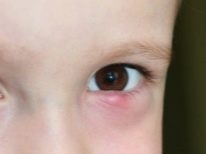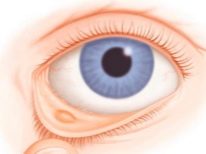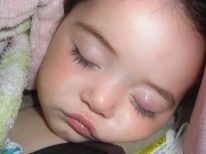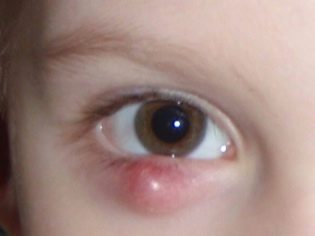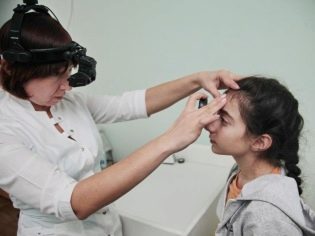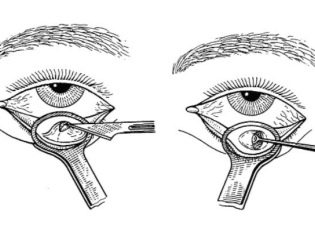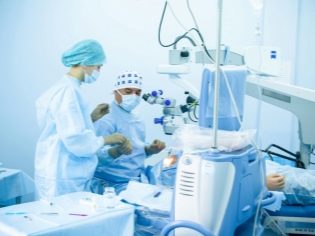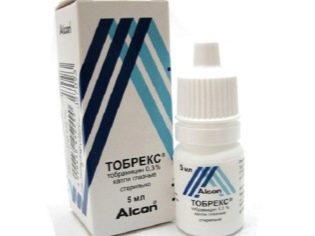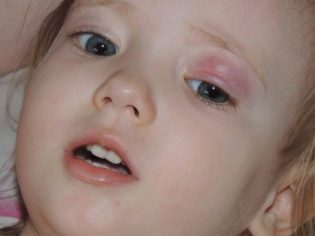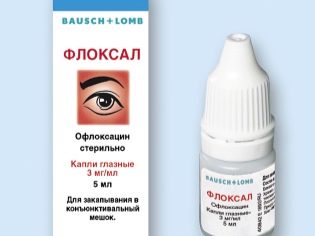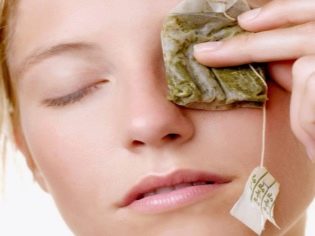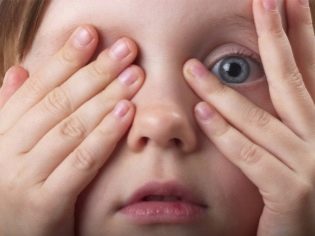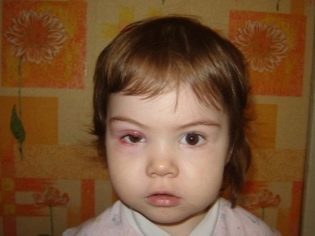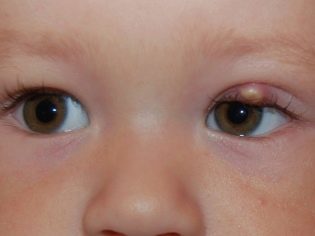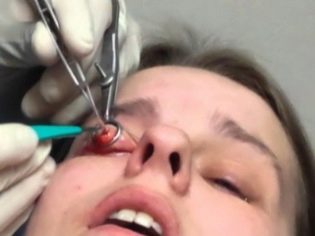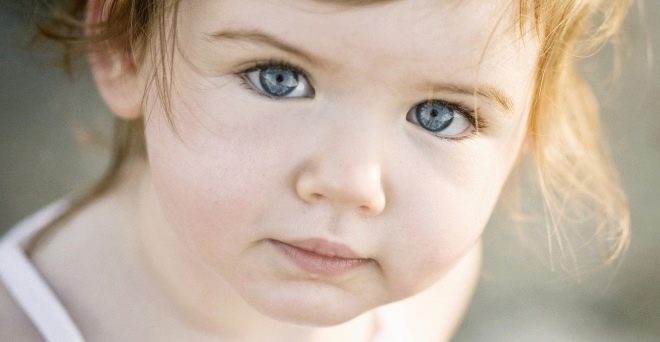Child halyazion
The term "chalazion" comes from the Greek language and literally translates as "hail". By this is meant a pathological increase in the meibomian gland. The clinical picture, especially in the early stages of development, of the pathological process is very similar to another ophthalmologic disease - barley. The treatment of this disease is very long and it often happens that conservative therapies are not so successful.
What should be the actions of parents when the first symptoms of chalazion appear in a child, what is the secret of successful treatment and how to avoid relapses, we will tell in this article.
What it is?
In the cartilage of the upper and lower eyelids, the person has specific sebaceous glands with a branched system of ducts called meibomian. Their more accurate localization - the inner part of the skin of the eyelids near the ciliary edge. The ducts of the meibomian glands open in the zone of growth of the eyelashes. On average, each person has about 35-50 such glands in the upper eyelid and 20-30 in the lower eyelid.
Meibomian glands produce a special secret, which is one of the structural components of the tear film that moisturizes the eyes. Also, the secret is needed to lubricate the cornea and moisturize the edges of the eyelids. He performs the role of a peculiar amartizer in the mechanism of contact of the edges of the eyelids with the surface of the eyes. Also, the fat secretion of the meibomian gland regulates the level of moisture of the eye with the tear fluid, preventing it from excessive evaporation.
When meibomian gland becomes inflamed, its ducts are blocked, which inevitably leads to disruption of the normal outflow of fat secretion. Gradually, it begins to accumulate inside the gland, which causes its gradual increase. The area of accumulation of the secret turns into a round seal, separated from the neighboring tissues by a connective tissue capsule.
In the course of numerous studies, it was found that chalazion consists of granulation tissue, as well as a multitude of epithelioid and giant cells. If pathogenic pathogen gets there, may develop purulent inflammatory process that ends with the formation of an abscess (purulent exudate, isolated from nearby tissues by a dense connective tissue capsule). In this case, pronounced signs of inflammation will appear in the zone of formation of the chalazion: swelling and redness of the skin, pain.
Sometimes it happens that a chalazion breaks through without any intervention. In its place a fistula may form, which is a channel connecting the chalazion capsule and the surface of the eyelid skin. Granulations (areas of tissue growth) appear near the cutaneous opening of the fistula. The skin in this area becomes inflamed and very sensitive.
The development of the disease is quite long and has a recurring nature (the reappearance of such a consolidation), in this case, conservative treatment can be long and not give the desired result.
Then the only effective method to help get rid of the chalazion remains surgical removal. But despite this, in the early stages of treatment, most ophthalmologists prefer drug therapy for the disease, considering the operative method as an extreme measure, especially if the patient is a child.
Features of treatment
There is a persistent belief in the medical environment that the formation of a chalazion occurs under the influence of the same pathogenic microflora as barley. From this it follows that the therapy of the disease must first be directed to the destruction of the pathogen. However, in any case, the treatment strategy is determined by the ophthalmologist after examining the child. It is extremely undesirable to engage in self-treatment, since only a specialist can differentiate the disease among other ophthalmologic pathologies and prescribe adequate therapy.
When symptoms are weak and the pathological process is sluggish, conservative methods of treatment help children, but the course of therapy in such cases can be quite lengthy.
In cases of acute manifestation of the clinical signs of chalazion, its surgical removal can be applied.
Antibacterial therapy involves the use of disinfecting eye drops or ointments, among which "Tobreks", yellow mercury and hydrocortisone ointment, as well as Vishnevsky ointment, etc. With prolonged treatment, the ophthalmologist may prescribe the administration of medicinal injections directly into the cavity of the chaliasion. This technique is quite effective, but children are prescribed it with caution, since this procedure is accompanied by a number of side effects.
Eye drops "Tobrex"Have a wide spectrum of action. They belong to the pharmacological group of aminoglycosides. The main active ingredient of the drug is tobramycin, it is able to fight with streptococcal and staphylococcal infections, intestinal and Pseudomonas aeruginosa, enterobacter and Klebsiella. However, the droplets do not exhibit activity when interacting with group B streptococcus. Additional components of the preparation: sodium chloride, boric acid, purified water.
«Tobrex"Is very effective in treating chalazion, as well as other inflammatory eye diseases such as keratitis (corneal inflammation), conjunctivitis (inflammation of the conjunctiva - eye mucosa), blepharitis (inflammation of the eyelid), etc. Also, drops are prescribed as a disinfectant in the postoperative period. The course of treatment for children should not exceed a week. In the acute phase of the disease, the instillations with the preparation are made at least 3-4 times a day. Contraindications: hypersensitivity to one of the components of the drug.
It is necessary to strictly adhere to the mode of instillation of eyes prescribed by a doctor. It is impossible to voluntarily increase the number of instillations per day or use the drug for longer than the prescribed course of treatment. During treatment with this agent perhaps wearing contact lenses.
Eye drops «Floksal» able to have an effective action in the fight against pathogenic microflora represented by obligate and facultative anaerobes, as well as aero-filaments and chlamydia. Ofloxacin is the main active ingredient of the drug. The use of "Floksal" is advisable in the treatment of infectious diseases such as chalazion, keratitis, conjunctivitis, blepharitis, barley, corneal ulcer, etc. The drug treatment course is not more than two weeks. Contraindications: hypersensitivity to one of the components of the drug.
You can not begin to apply the "Floxal" without the appointment of an ophthalmologist. During the course of drug treatment can not wear contact lenses.
Eye drops «Cypromed» have antiseptic and anti-inflammatory effects. The drug shows high efficiency in the fight against gram-positive and gram-negative pathogenic microflora. “Cipromed” refers to the group of fluoroquinolones.
Ophthalmologists recommend using “Cypromed” for the treatment of the following inflammatory diseases: chalasion, conjunctivitis, uveitis, keratitis, blepharitis, dacryoscystitis, and so on. The course of drug treatment should not exceed two weeks.Contraindications: hypersensitivity to one of the components of the drug. “Cipromed” is not prescribed for the treatment of chalazion for children under one year old.
No need to try at home without prior consultation with an ophthalmologist to treat chalazion with folk remedies (for example, a variety of decoctions and lotions with calendula, chamomile, aloe juice, etc.) and other questionable alternative methods (homeopathy, various conspiracies, etc.) .
The well-known children's doctor Komarovsky in our country, whose opinion is authoritative not only for many Russian parents, but also for most pediatricians, insists that in the case of a chalazion in a child you must first resort to the standard methods of traditional medicine, and not to the “grandmother's” recipes, which not only do not help to get rid of the chalazion, but can also be dangerous to the health of the child (especially when it comes to the treatment of infants).
Symptoms
The main sign of the development of this disease is the formation of swelling in the region of the edge of the eyelid, closer to the eyelash growth line. In the future, in its place appears elastic seal with smooth edges, shaped like a pea. Redness is observed on the inner surface of the eyelid.
Chalazion rarely causes pain in the eyelid area. If an infection joins with such a pathological process, then in addition all signs of an acute inflammatory process will appear: pain, swelling, redness, spontaneous opening of the purulent exudate from the inner edge of the eyelid is also possible. In such cases, treatment includes antibacterial and anti-inflammatory therapy, as well as application physiotherapeutic treatments.
Halyazion during the initial inspection is a lot like barley. They differ in that the barley after the "breakthrough" of pus outward usually resolves and all symptoms gradually disappear. Chalazion, in turn, rarely breaks through, gradually gaining in size and becomes quite dense.
Meibomian gland occlusion can occur on one or two centuries.
If a child with a chalazion does not provide the necessary treatment for a long time, compaction can grow to those limits, when applying pressure on neighboring tissues, it can provoke the development of other diseases of the visual apparatus. therefore pull with a trip to an ophthalmologist should not, even if a painless seal on the eyelid does not cause your child any discomfort. Remember that conservative treatment of a chalazion is appropriate only in the initial stages of the disease or after it has broken through.
When the accumulated secret of the meibomian gland becomes denser, the problem can only be solved by surgical intervention, which in psychological terms is not so difficult for children as their frightened parents.
In children, cases of recurrent multiple chalazions are not often recorded. Usually a chalazion can appear again at the same place where it was previously removed. This is due to the fact that during the operation the tumor was not completely removed.
There is a theory that suggests that the presence of hyperopia (farsightedness) in a child contributes to the development of a chalazion. In any case, this type of refractive error requires eyeglass or contact correction, as well as other treatment methods (apparatus therapy, visual gymnastics, physiotherapy, etc.).
Chalazion may occur against the background of reduced immunity. It can also be explained by hereditary or acquired instability of the immune system to gram-positive microflora. In this case, a treatment plan should be drawn up with the participation of an immunologist.Chalazion may appear as a result of an anatomical defect, which is manifested by too narrow a lumen of meibomian glands, as a result of which the normal outflow of fat secretion is disturbed.
Another reason for the periodic blockage of the ducts of the meibomian glands is weak functional activity of the muscular systemaffecting the movement of secretions in a certain direction, as well as the low content of protective protein of secretory immunoglobulin tears. In such cases, usually the child periodically appears multiple chalazions.
A special massage of the eyelids can minimize the risk of chalazion, but the child still needs to be consulted by specialists.
Operative intervention
The decision on the need for surgical treatment is made by an ophthalmologist. At the same time, he should proceed from how long the course of medical treatment lasts and what the positive dynamics of recovery is. If the “pea” for a very long period does not pass and does not decrease, then most likely, the doctor will suggest its surgical removal.
The operation takes place by local anesthesia. If the patient is under 2 years old, then the manipulation will be performed under general anesthesia.
The whole procedure can be divided into several stages:
- Anesthetic injection into the eyelid cavity;
- After the onset of local loss of sensitivity, the seal is fixed at the base with a clamp;
- On the inner side of the eyelid, an incision is made through which the capsule is removed;
- Stitched over the incision;
- The century is treated with antiseptic agents;
- Finally, an aseptic dressing is applied to the eye.
During the postoperative period, the patient must wear a slightly pressure bandage for a while. You need to remove it only before laying ointment under the eyelid.
In addition to surgical extraction of the seal from the thickness of the century with a scalpel, There is a method of removing the Chalazion laser. This technique has some advantages over the usual operation on the eyelid, among them the main thing is the absence of the need to stitch after the completion of the manipulation, as well as the fact that the operation is completely bloodless. Naturally, thanks to this, the period of complete recovery after surgery is significantly reduced, and after this procedure it is not necessary to wear a bandage for a long time. Parents reviews about this method are mostly positive.
In the event that a scar remains after the operation, which, with regular contact with the surface of the cornea, creates the danger of damage, it is necessary to wear special lenses to prevent complete friction until the wound heals completely.
How to treat chalazion in children, see the following video.


